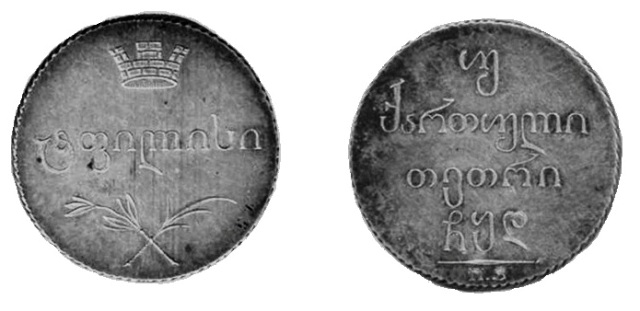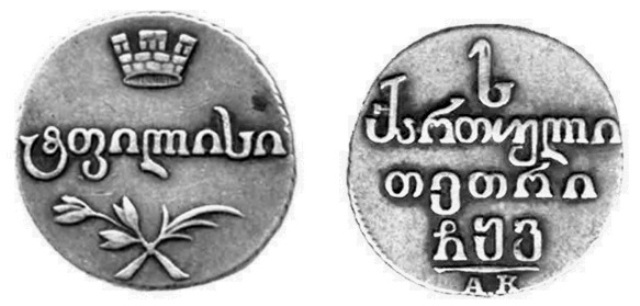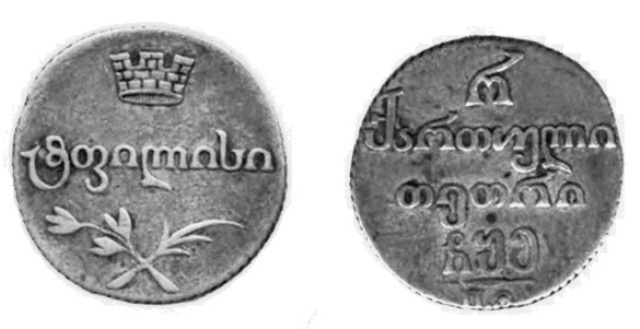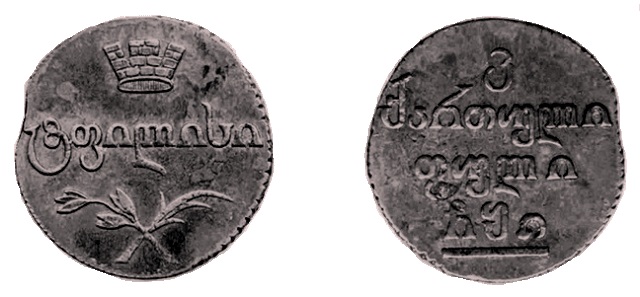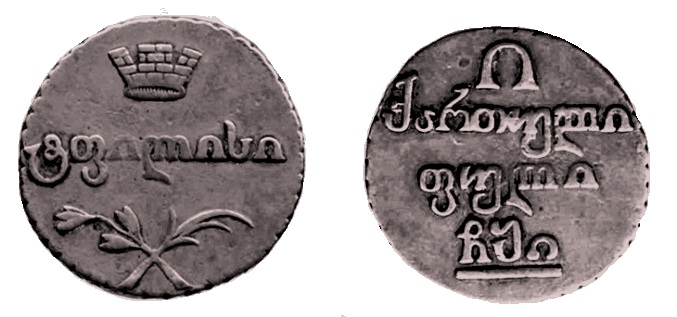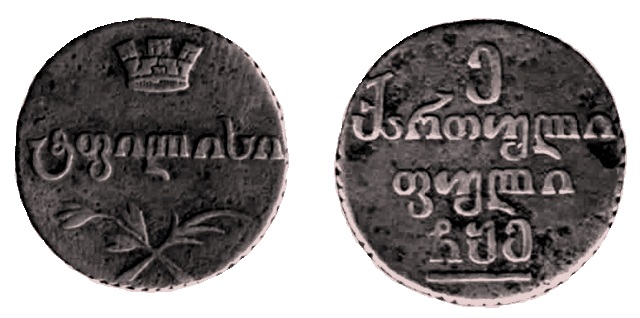Russo-Georgian coins struck at Tbilisi in 1804-1834 with the effigy of crown
Type: Russo-Georgian coins struck at Tbilisi in 1804-1834 with the effigy of crown
Description, picture:
Silver.
1. Two abazis/40 kopecks. Silver. Weight – 6,23 gr. d=25 mm.
Obverse: Crown, palm and olive branches. Georgian legend – ტფილისი Tbilisi.
Reverse: Georgian legend: უ /ქართული/თეთრი/ჩყდ 400 (two abbasis are equal to 400 the smallest copper units of account – authors)/Georgian/tetri (silver)/1804. Russian legend, initials of die-engraver: П. З.
2. Abazi/20 kopecks. Silver. Weight – 3,09 gr. d=19 mm.
Obverse: Crown, palm and olive branches. Georgian legend – ტფილისი Tbilisi.
Reverse: Georgian legend: ს/ქართული/თეთრი/ჩყვ 200/Georgian/tetri/1806. Russian legend, initials of die-engraver: А. К.
3. Uzaltuni/10 kopecks. Silver. Weight – 1,55 gr. d=16 mm.
Obverse: Crown, palm and olive branches. Georgian legend – ტფილისი Tbilisi.
Reverse: Georgian legend: რ/ქართული/თეთრი/ჩყე 100/Georgian/tetri/1805. Russian legend, initials of die-engraver: П. З.
Copper.
4. Bisti/2 kopecks. Copper. Weight – 14,87 gr. d=30/31 mm.
Obverse: Crown, palm and olive branches. Georgian legend – ტფილისი Tbilisi.
Reverse: Georgian legend: კ/ქართული/ფული/ჩყი 20/Georgian/puli (copper)/1810.
5. Half bisti/1 kopeck. Copper. Weight – 6,96 gr. d=24/25 mm.
Obverse: Crown, palm and olive branches. Georgian legend – ტფილისი Tbilisi.
Reverse: Georgian legend: ი/ქართული/ფული/ჩყი 10/Georgian/puli/1810.
6. Puli/half kopeck. Copper. Weight – 3,9 gr. d=20 mm.
Obverse: Crown, palm and olive branches. Georgian legend – ტფილისი Tbilisi.
Reverse: Georgian legend: ე/ქართული/ფული/ჩყე 5/Georgian/puli/1805.
Silver.
1. Two abazis/40 kopecks. Silver. Weight – 6,23 gr. d=25 mm.
Obverse: Crown, palm and olive branches. Georgian legend – ტფილისი Tbilisi.
Reverse: Georgian legend: უ /ქართული/თეთრი/ჩყდ 400 (two abbasis are equal to 400 the smallest copper units of account – authors)/Georgian/tetri (silver)/1804. Russian legend, initials of die-engraver: П. З.
2. Abazi/20 kopecks. Silver. Weight – 3,09 gr. d=19 mm.
Obverse: Crown, palm and olive branches. Georgian legend – ტფილისი Tbilisi.
Reverse: Georgian legend: ს/ქართული/თეთრი/ჩყვ 200/Georgian/tetri/1806. Russian legend, initials of die-engraver: А. К.
3. Uzaltuni/10 kopecks. Silver. Weight – 1,55 gr. d=16 mm.
Obverse: Crown, palm and olive branches. Georgian legend – ტფილისი Tbilisi.
Reverse: Georgian legend: რ/ქართული/თეთრი/ჩყე 100/Georgian/tetri/1805. Russian legend, initials of die-engraver: П. З.
Copper.
4. Bisti/2 kopecks. Copper. Weight – 14,87 gr. d=30/31 mm.
Obverse: Crown, palm and olive branches. Georgian legend – ტფილისი Tbilisi.
Reverse: Georgian legend: კ/ქართული/ფული/ჩყი 20/Georgian/puli (copper)/1810.
5. Half bisti/1 kopeck. Copper. Weight – 6,96 gr. d=24/25 mm.
Obverse: Crown, palm and olive branches. Georgian legend – ტფილისი Tbilisi.
Reverse: Georgian legend: ი/ქართული/ფული/ჩყი 10/Georgian/puli/1810.
6. Puli/half kopeck. Copper. Weight – 3,9 gr. d=20 mm.
Obverse: Crown, palm and olive branches. Georgian legend – ტფილისი Tbilisi.
Reverse: Georgian legend: ე/ქართული/ფული/ჩყე 5/Georgian/puli/1805.
Scholarly commentary:
In 1801 Russian administration was already there in Kartl-Kakheti. Old Tbilisi mint was closed. But this measure created a problem – shortage of silver and copper coins. The money sent from Russia could not fill up the gap, it was coming slowly. Scarcity of silver lowered the rate of Russian gold coin (Dutch ducats, called Lobanchiks), which was quite high in other places. Merchants had good profit thanks to low exchange rate of gold. Cheap Iranian goods flooded Georgian market taking back coins, thus making crisis more severe.
Imperial government had to think about restoration of Tbilisi mint and local silver and copper issue. They decided that future coin, with ostensible Georgian features, would be struck according to the Russian monetary system. Russian “liberal” emperor Alexander I ordered “to put nothing Russian” on the Georgian coins.
So, the situation was to be changed. Preparations were made for reorganization of old Tbilisi mint, now under the Russian control. On September 15 of 1804 there was the mint inaugurated in the former royal bath celebrated by issue of the commemorative medal.
Russian government imposed unified type for silver and copper coins struck at Tbilisi.
Silver coins were struck at Tbilisi in 1804-1834 and copper coins – in 1804-1810. The following silver nominals were issued: 40, 20 and 10 kopecks; and copper nominals are as follows – 2, 1 and half kopeck. Dates and nominals are indicated by the Georgian letters: უ (=400), ს (=200) and რ (=100) for 40, 20 and 10 kopecks; კ (=20), ი (=10) and ე (=5) for 2, 1 and half kopecks.
There are the Russian initials placed under a date on the silver coins: П. З. – Peter Zaitsev, А. Т. – Alexander Trifonov, А. К. – Alexei Karpinsky, В. К. – Vasil Kleimenov. They were die-engravers.
Tbilisi mint, established on September 15th 1804 and functioning up to February 13th 1834 (coins issued in 1834 have the date 1833), produced silver money 1060714 roubles and 30 kopecks, and copper money 8310 roubles and 89,5 kopecks. Issue of the coins was not regular; ex. there is no issue for 1825. Sometimes only certain nominals were struck. Sometimes issue was large, sometimes – not. Consequently, some coins are rare, ex. silver coins of 1804, 1810 and 1811. All copper nominals of 1804 are very rare.
D. Kapanadze has special table in his textbook with all the nominals and the dates of issue.
In 1801 Russian administration was already there in Kartl-Kakheti. Old Tbilisi mint was closed. But this measure created a problem – shortage of silver and copper coins. The money sent from Russia could not fill up the gap, it was coming slowly. Scarcity of silver lowered the rate of Russian gold coin (Dutch ducats, called Lobanchiks), which was quite high in other places. Merchants had good profit thanks to low exchange rate of gold. Cheap Iranian goods flooded Georgian market taking back coins, thus making crisis more severe.
Imperial government had to think about restoration of Tbilisi mint and local silver and copper issue. They decided that future coin, with ostensible Georgian features, would be struck according to the Russian monetary system. Russian “liberal” emperor Alexander I ordered “to put nothing Russian” on the Georgian coins.
So, the situation was to be changed. Preparations were made for reorganization of old Tbilisi mint, now under the Russian control. On September 15 of 1804 there was the mint inaugurated in the former royal bath celebrated by issue of the commemorative medal.
Russian government imposed unified type for silver and copper coins struck at Tbilisi.
Silver coins were struck at Tbilisi in 1804-1834 and copper coins – in 1804-1810. The following silver nominals were issued: 40, 20 and 10 kopecks; and copper nominals are as follows – 2, 1 and half kopeck. Dates and nominals are indicated by the Georgian letters: უ (=400), ს (=200) and რ (=100) for 40, 20 and 10 kopecks; კ (=20), ი (=10) and ე (=5) for 2, 1 and half kopecks.
There are the Russian initials placed under a date on the silver coins: П. З. – Peter Zaitsev, А. Т. – Alexander Trifonov, А. К. – Alexei Karpinsky, В. К. – Vasil Kleimenov. They were die-engravers.
Tbilisi mint, established on September 15th 1804 and functioning up to February 13th 1834 (coins issued in 1834 have the date 1833), produced silver money 1060714 roubles and 30 kopecks, and copper money 8310 roubles and 89,5 kopecks. Issue of the coins was not regular; ex. there is no issue for 1825. Sometimes only certain nominals were struck. Sometimes issue was large, sometimes – not. Consequently, some coins are rare, ex. silver coins of 1804, 1810 and 1811. All copper nominals of 1804 are very rare.
D. Kapanadze has special table in his textbook with all the nominals and the dates of issue.
Date | Two abazis უ (=400) | Abazi ს (=200) | Uzaltuni რ (=100) | 2 kopecks კ (=20) | 1 kopeck ი (=10) | ½ kopeck ე (=5) |
| 1804 ჩყდ | П. З. | П. З. П. З. | П. З. | O | O | O |
| 1805 ჩყე | П. З. | П. З. | П. З. | O | O | O |
| 1806 ჩყვ | А. К. | П. З. А. К. | А. К. | O | O | O |
| 1807 ჩყზ | А. К. | А. К. | – | – | – | – |
| 1808 ჩყჱ | А. К. | А. К. | – | O | O | – |
| 1809 ჩყთ | А. К. | А. К. | – | – | – | – |
| 1810 ჩყი | А. Т. | А. Т. | – | O | O | – |
| 1811 ჩყია | А. Т. | – | – | – | – | – |
| 1812 ჩყიბ | А. Т. | А. Т. | – | – | – | – |
| 1813 ჩყიგ | А. Т. | А. Т. | А. Т. | – | – | – |
| 1814 ჩყიდ | А. Т. | А. Т. | – | – | – | – |
| 1815 ჩყიე | А. Т. | А. Т. | – | – | – | – |
| 1816 ჩყივ | А. Т. | А. Т. | – | – | – | – |
| 1817 ჩყიზ | А. Т. | А. Т. | – | – | – | – |
| 1818 ჩყიჱ | А. Т. | А. Т. | – | – | – | – |
| 1819 ჩყით | А. Т. | А. Т. | – | – | – | – |
| 1820 ჩყკ | А. Т. | А. Т. | O | – | – | – |
| 1821 ჩყკა | А. Т. | А. Т. | O | – | – | – |
| 1822 ჩყკბ | А. Т. А. К. | А. Т. А. К. | А. К. | – | – | – |
| 1823 ჩყკგ | А. К. | А. К. | А. К. | – | – | – |
| 1824 ჩყკდ | А. К. | А. К. | А. К. | – | – | – |
| 1825 ჩყკე | – | – | – | – | – | – |
| 1826 ჩყკვ | А. Т. А. Т. | А. Т. А. Т. | А. Т. | – | – | – |
| 1827 ჩყკზ | А. Т. | А. Т. | А. Т. | – | – | – |
| 1828 ჩყკჱ | А. Т. O | А. Т. O | А. Т. O | – | – | – |
| 1829 ჩყკთ | А. Т. | – | – | – | – | – |
| 1830 ჩყლ | А. Т. | А. Т. | – | – | – | – |
| 1831 ჩყლა | А. Т. В. К. | А. Т. | А. Т. | – | – | – |
| 1832 ჩყლბ | В. К. | – | В. К. | – | – | – |
| 1833 ჩყლგ | В. К. | – | В. К. | – | – | – |
Mint: Tbilisi.
Nominal: Two abazis (40 kopecks), abazi (20 kopecks), uzaltuni (10 kopecks), bisti (2 kopecks), half bisti (1 kopeck), puli (half kopeck).
Date: 1804-1834.
Collection: Simon Janashia Museum of Georgia – ex. QF. (Main Fund of the Georgian Coins, Numismatic Collection, Simon Janashia Museum of Georgia) №№5696-5812, №№5849-5868.
Bibliography:
G. Dundua. Money in Georgia (Georg. and Engl. parallel texts). Tb. 2003 (2nd Edition) (T. Dundua, N. Javakhishvili and A. Eristavi as co-authors); Georgian Numismatic Dictionary. Tb. 2009 (Ir. Jalaghania as co-author) (in Georg.); Georgian Numismatics. II. Tb. 2011 (T. Dundua as co-author) (in Georg.).
D. Kapanadze. Georgian Numismatics. Tb. 1969 (in Georg.).
Д. Г. Капанадзе. Грузинская нумизматика. М. 1955.
T. Dundua. Georgia within the European Integration. Graeco-Roman World, Byzantine Commonwealth, Orthodox Alliance and the Georgians. Tb. 2013.
G. Dundua. Money in Georgia (Georg. and Engl. parallel texts). Tb. 2003 (2nd Edition) (T. Dundua, N. Javakhishvili and A. Eristavi as co-authors); Georgian Numismatic Dictionary. Tb. 2009 (Ir. Jalaghania as co-author) (in Georg.); Georgian Numismatics. II. Tb. 2011 (T. Dundua as co-author) (in Georg.).
D. Kapanadze. Georgian Numismatics. Tb. 1969 (in Georg.).
Д. Г. Капанадзе. Грузинская нумизматика. М. 1955.
T. Dundua. Georgia within the European Integration. Graeco-Roman World, Byzantine Commonwealth, Orthodox Alliance and the Georgians. Tb. 2013.
Imported coins found in Georgia:
In the 19th c. we have already paper money being in circulation together with the coins.
In the 19th c. we have already paper money being in circulation together with the coins.
